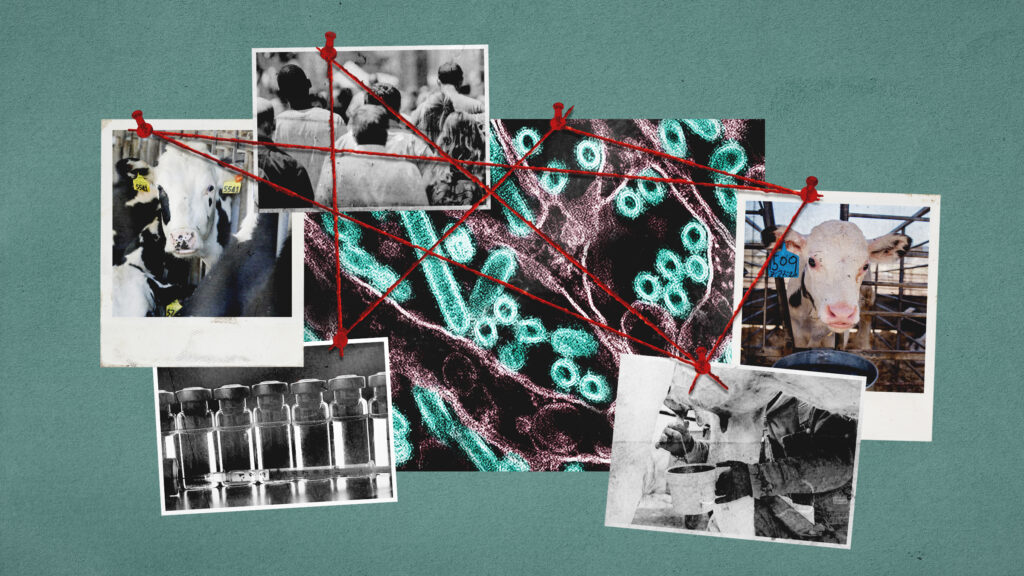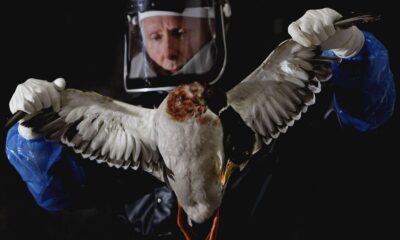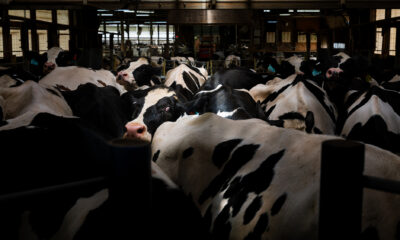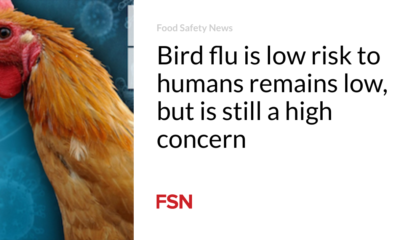Health
The most pressing bird flu mysteries scientists want answered- STAT

Ten weeks after government scientists discovered that H5N1 bird flu was sickening dairy cattle in the United States, many of the mysteries surrounding what is happening on affected farms remain just that.
Widespread reluctance on the part of farmers to allow scientists — government or otherwise — onto their premises to study spread of the virus among infected cows has created a frustrating lack of understanding of the dynamics of this outbreak. U.S. Department of Agriculture incentives aimed at getting farmers to test their cows and take preventive measures to protect both animals and farmworkers do not seem to have solved the impasse, even as the outbreak has affected 82 herds in nine states.
It’s not lost on many scientists, here and abroad, that the paucity of data coming out of the U.S. is not dissimilar to the limited information flow out of China in the early days of the Covid-19 pandemic — a situation the U.S and other governments complained about loudly at the time. With the shoe on the other foot, however, there is no overt effort to make farmers cooperate.
“A lot of criticism was leveled at China for their early response to Covid-19 — some of it reasonable, a lot of it extremely ignorant. Are we currently making some of those mistakes ourselves?” wondered Kristian Andersen, an evolutionary biologist and a professor of immunology and microbiology at Scripps Research Institute in La Jolla, Calif.
Investigating outbreaks always takes time. But it is startling this far into this situation that so many questions appear to be no closer to answers.
To get a sense of what the key questions are, STAT asked scientists who have long worked on influenza or in veterinary medicine what they viewed as the most pressing questions. Sixteen answered individually; the Centers for Disease Control and Prevention answered collectively for three flu experts within its ranks whose opinions we sought.
The answers — their questions — roughly fit into three buckets: What’s happening on the farms among cows? What’s happening on farms among farmworkers? What’s happening to the virus and what does this all portend for H5N1, which for nearly three decades has danced around humans but has yet to take us on directly.
The biggest bucket: What is happening with the cows?
Ron Fouchier, a flu virologist at Erasmus Medical Center in the Dutch city of Rotterdam, summed up what underlies all of the cow-related questions with the single question he submitted. It was, effectively: How can spread in cows be stopped, and the sooner the better?
“If this virus becomes enzootic” — endemic or entrenched — “in cows, it could well cause massive damage to human and animal health in the longer term,” Fouchier wrote. “I would find it unacceptable if authorities in the U.S.A. and/or the sector do not try to eradicate this new disease in cows a.s.a.p. If this is not deemed possible, I think the entire world would like to see the evidence and arguments.”
Isabella Eckerle, a virologist at the Geneva Centre for Emerging Viral Diseases, expressed a similarly overarching sentiment. “What is the plan of farmers and health authorities to get rid of this virus in the cow population to prevent further spread and mutation, or worse, major spillover to humans?”
Figuring out how to stop the spread of the virus in U.S. cattle herds requires far more information than exists in the public domain, however. Many of the experts we asked said what’s known about how the virus is spreading among cows cannot be the whole story.
Cow udders appear to be exquisitely sensitive to this virus; when dairy cattle are infected, their milk production decreases markedly and the milk they do produce is altered in color and viscosity. Milk from infected animals contains surprisingly high levels of virus. It’s believed that milking machines, which are not cleaned after each cow is milked, have been spreading the virus from infected to uninfected animals.
But some cows reportedly have mild respiratory symptoms and nasal discharge, raising questions about whether cows are also spreading the virus more in the way humans spread flu.
“There is a consensus building that this is most likely mechanical transmission through milking but I don’t think that answers a lot of questions/explains some of the weirdness,” said Thomas Peacock, an influenza virologist at the Pirbright Institute, a British organization that focuses on controlling viral illnesses in animals. “I don’t understand how if the virus is only transmitting through milk machines it got back into poultry (or alpacas!).”
While it is believed that this outbreak was caused by a single “spillover” event, when H5N1-infected wild birds somehow passed the virus to a cow or cows, the virus that has been spreading in cows has since spilled back into wild birds. Farm cats, domestic poultry, the odd carnivore species, and a herd of alpacas in Idaho have also been infected with this strain of the virus. Six of 18 alpacas in the herd became infected; three that were pregnant had spontaneous abortions.
There have also been three mild human infections associated with this outbreak; all have been in farmworkers.
Martin Beer, director of the Institute of Diagnostic Virology at the Friedrich-Loeffler-Institut in Riems, Germany, lists a number of data points scientists need to know to try to figure out how to stop this outbreak. The number of cows in a herd that have been infected, which could be determined by looking for antibodies in their blood. The percentage of animals that shed virus — in other words, the portion that are infectious. Whether they emit virus from their muzzles or in their feces. How much virus is shed via those routes as compared to what is seen in milk?
Scott Hensley, a professor of microbiology at the University of Pennsylvania’s Perelman School of Medicine who is working on an H5N1 vaccine, has a trio of intertwined questions. Do cows that are infected but have no symptoms emit virus? Would quarantining infected cows stop spread within a herd? And how long are infected cows infectious? “It will be easier to control this virus if the infectious period is short. But this might not be the case,” Hensley noted.
Colleen Webb agreed that the specifics of spread in cattle need to be elucidated. “We know the basic epidemiological information for other avian influenza hosts, but not dairy cattle, and dairy cattle are different enough from these other hosts that we need dairy cattle-specific information,” said Webb, dean of the graduate school at Colorado State University, whose research focuses on data-driven modeling of disease and evaluation of preparedness and control strategies in livestock diseases.
Lots of data from a number of affected farms would answer these questions. In the absence of it, experimental infections of cows in laboratories can start to generate crucial information. Jürgen Richt, a veterinarian and director of the Center of Excellence for Emerging and Zoonotic Animal Diseases at Kansas State University’s College of Veterinary Medicine, is currently doing just this type of research. So is Beer.
Florian Krammer, a flu virologist at the Icahn School of Medicine at Mount Sinai in New York, thinks it’s important to find out whether vaccinating cattle would stop transmission of the virus in herds — specifically whether vaccine doses created for people in the federal government’s stockpile could be used to tamp out spread. “Large scale vaccination in cows may be able to stop the outbreak,” he argued.
There remains the question of how widespread the virus is in herds in the U.S. Given that H5 viral particles have been found in a substantial portion of commercially purchased milk — one in five samples bought in 38 states — the belief is that the herds that have been confirmed are a tip of the iceberg. But is that so? How far has this spread?
“We still don’t know how many farms are affected and that’s a big problem for containment. As long as undetected cases are out there, new infections can and will occur,” said Angela Rasmussen, a virologist at the Vaccine and Infectious Disease Organization at the University of Saskatchewan, in Saskatoon, Canada.
Like Rasmussen, Diego Diel, a virologist at Cornell University in Ithaca, N.Y., would like to know how far the virus has spread in cows. “Is the virus circulating in other countries … such as Mexico and Canada?” he wondered. So far Canadian authorities report they have not found the virus in cows. And work Rasmussen and an ad hoc team of researchers from across Canada have done looking for traces of H5N1 in store-bought milk has so far failed to turn up any positive results.
Finally, there is the question of whether this virus is now on its way to being seeded in cattle in the United States — permanently circulating among cows and adapting to better infect them. Will cows who have recovered from the virus have the capacity to catch it again? Humans, after all, only develop transient immunity when they have a bout of flu.
“What is going to happen when a recovered herd gets infected again? Maybe someone knows the answer to this already, but I don’t,” said Richard Webby, a flu virologist and director of the World Health Organization’s Collaborating Center for Studies on the Ecology of Influenza in Animals, located at St. Jude Children’s Research Hospital in Memphis, Tenn. “Will this disease burn out, or continue to circulate?”
Webby wondered whether cows can be reinfected, and if so, whether subsequent infections differ from the initial one, with potentially different amounts of virus in the milk of infected cows, for instance. Though experimental infections might help to start generating an answer to this question, the best way to answer it would be to monitor farms that have been affected.
Andersen worries what the consequences will be if we get to the point where this question can be answered. “We will eventually find out, however, this is a good example of ‘Let’s not,’” he said. “Let’s just focus on stopping the current epizootic in cattle.”
What’s happening to farmworkers?
Within days of the USDA’s confirmation that H5N1 was infecting cows in some herds in Texas, Kansas, and Michigan, a human infection was confirmed. A farm worker developed a florid case of conjunctivitis — pink eye. A swab of his eye contained the bird flu virus.
Since then, two more bird flu cases have been detected in people, both in Michigan. One also had conjunctivitis, but more recently a farmworker developed more classical flu-like symptoms.
There have also been many anecdotal reports of other cases of conjunctivitis on affected farms, and experts believe there have been more human cases than have been confirmed. In addition to the reluctance of farmers to cooperate with authorities trying to study the situation, many of these workers are migrants. Some are likely undocumented. Many may not have access to health care, and may be frightened about interacting with government officials.
There is great interest in doing serology studies among farm workers — drawing blood to look for antibodies to H5N1 to try to get a handle on how often the virus is infecting people on farms. Getting approval to do this work has been challenging. The Texas farmworker refused to give blood.
Without better access to workers, it’s hard to assess where the risk is highest on dairy farms, and hard to put together practical, usable programs to protect them.
“While we know that people with direct, unprotected exposure to animals infected with H5N1 are the most likely to get sick with the virus themselves, CDC is still working to determine how exactly that infection occurs,” the agency told STAT in its submitted questions. “Understanding and defining the specific risky behaviors is important so that we can then translate that into the best means of prevention.”
Meghan Davis concurred. A dairy and mixed animal veterinarian who teaches in Johns Hopkins University’s department of environmental health and engineering and medical school, Davis said that understanding specifically how workers are being exposed on farms could lead to the identification of better ways to use personal protective equipment or even other protective approaches that don’t involve PPE. Farmworkers have been reluctant to wear masks and goggles; the heat in barns makes these tools impractical and even potentially dangerous, impeding their vision of what’s going on around them.
“This would be done with exposure studies on positive farms that would involve sampling of a lot of pathways of exposure — air, water, waste — and would include what we call personal exposure assessment,” she said.
Rasmussen would like to know whether the route of exposure to the virus — a splash of milk in the eye, say, versus inhalation of virus-laced particles — affects the type of infection an exposed individual develops, and the severity of the ensuing illness.
What is happening to the virus?
Since H5N1 was first isolated from a goose in China’s Guangdong province in 1996, the virus has undergone extensive evolution. There are now several clades — sub-families, if you will — of the virus circulating in various parts of the world, moved around by wild birds. The version responsible for the outbreak in cows is a virus identified as clade 2.3.4.4b, genotype B3.13. While this clade also circulates in Europe, the B3.13 genotype has not been spotted there.
Until this outbreak, cows were never thought to be susceptible to H5N1. Beer had shown calves could be infected in a lab, but in the real world, cows had never been part of the H5 story.
Is this outbreak a sign that something about the virus changed? Or was it just a lightning strike? This is a question a number of the scientists had.
“Are other 2.3.4.4b viruses with other gene constellations also able to infect cattle?” wondered Kanta Subbarao, a flu virologist at Laval University in Quebec City, Canada.
Richt, the veterinarian from Kansas State University who is experimentally infecting dairy cattle, also wants to know whether this H5 virus is special, or if it just got lucky. “Nobody knows whether this ‘bovine H5N1’ is unique or not. Maybe regular ‘avian H5N1’ viruses are able to infect cattle too,” he said. Beer wants to know whether this version of the virus has changes that allow it to infect the mammary gland so efficiently, or whether other versions of 2.3.4.4b — ones circulating in Europe, say — could also do this if they got the opportunity.
Yoshihiro Kawaoka put into words a question that worries many scientists watching this situation, the worry that underscored Fouchier’s insistence that this outbreak must be stopped as quickly as possible. “We do not know whether the bovine H5N1 virus will become established in cattle,” wrote Kawaoka, a flu virologist at the University of Wisconsin-Madison. “If it does, will it evolve to adapt more towards ‘mammalian-like’ influenza viruses? … Will it pose a risk to human health?”
To date, the virus has not been seen to have the capacity to transmit efficiently among a mammalian species; any changes it acquires to allow it to do that could make H5N1 more adept at infecting humans.
Eckerle wonders if we’d know it, in real time, if the virus starts to change in ways that might signal dangerous adaptations for mammal-to-mammal spread. The USDA has been uploading basic genetic data to an international database, but those sequences do not indicate when the virus was collected or in which part of the country. It has been slow to share more complete genetic sequences, to the deep frustration of the scientific community. With this approach, there might be a delay in recognizing the development.
An intriguing curveball
Malik Peiris, who has studied the H5N1 virus since it started to infect people back in 1997 in Hong Kong, raised an intriguing and potentially hopeful question. Peiris, who is chair of virology at the University of Hong Kong’s School of Public Health, wonders whether the risk that H5N1 poses to people has changed in the decades since H5 first started infecting humans. Over the years, close to 900 people in 24 countries are known to have been infected, and about half of them have died.
Peiris and colleagues wonder, though, whether the 2009 H1N1 pandemic lowered the risk H5N1 poses. The neuraminidase protein on the 2009 virus, the N1, is quite similar, genetically, to the neuraminidase in H5N1. His group in Hong Kong has tested the blood of people who likely had H1N1 — which has circulated in the years since the 2009 pandemic — and tested stored blood samples from before 2009, looking to see if, when exposed to H5N1 virus, cross-reactive antibodies that might kickstart an immune response to H5N1 are present.
Their study is small, but suggestive that because of how similar the viruses are, some people may have antibodies that could help in the face of H5N1 exposure. It should be noted that in the years since 2009, there have been about 425 detected cases of H5N1 infection worldwide, of which about 180 were fatal. In the past decade, though, human cases have been less frequent and somewhat less likely to end in death.
“We need to ascertain how much protection this cross-N1 antibody will provide against H5N1 infection, at least to mitigate disease severity,” Peiris said, adding that his group is continuing to work on this question. “The question is what biological protective effect will they exert, if any?”
Andrew Joseph contributed reporting.













